The building block has been such a fact of American childhood for so long, it’s easy to dismiss the humble little cube as irrelevant, particularly in light of fancy newer digital toys that flash and whirr, sing ditties and announce “I love you” at random intervals. The fact is, those shouty toys can’t hold a candle to the building block and its equally modest cousin, the shape sorter.

“What those fancy toys don’t do is actually teach the child anything about spatial relationships,” says early learning scholar and author Dr. Roberta Michnick Golinkoff. “Parents think they’re getting a lot of bang for their buck because the toy doesn’t do just shapes, it does numbers! It sings! It talks!
Dr. Kathy Hirsh-Pasek, a Temple University professor, senior fellow at the Brookings Institution and co-author on these projects, added, “What our research demonstrates is that the parents who had good old fashioned blocks and shape-sorter toys spoke and interacted with their kids more than the parents who gave their children battery-operated ‘educational’ toys with 5 functions. It’s the interaction that makes the difference.”
Caregivers tend to take a back seat to the electronic toys and talk less about shapes and more about the functions of the toy itself—What happens when you push this button? Parents playing with traditional toys tend to follow the child’s lead in discovering what those toys do—They do stack on top of each other, don’t they? Let’s put the blue block on top of the red block!
Spatial knowledge underpins everything in modern life and provides the tools we use to visualize the world, get around and manipulate our environment. We can power a rocket, send it to the moon and have it return to a spot on the Earth’s surface the size of a city block because a bunch of engineers, scientists and mathematicians learned before they were 3 years old that stacking blocks on top of each other builds a tower and the triangle won’t go in that circle hole.
But where does that understanding come from? If children are left to their own devices in a room full of blocks, shape sorters and puzzles, will they sort it out on their own? Not so much, as it turns out.
In multiple studies, Golinkoff and Hirsh-Pasek and their colleagues found that children playing by themselves with objects such as blocks and shape toys will not learn the spatial concepts connected with those objects. In one study, children were randomly assigned to one of three teaching paradigms: guided play, didactic learning (an authority teaching the facts) or free play.
- In guided play, the experimenter worked with the children as detectives to discover the shapes’ “secrets,” asking questions and encouraging the child to touch or trace the shapes they presented on cards.
- The didactic experimenter showed the children the same materials but asked that they watch the researcher play detective, so that the children simply watched the action rather than act themselves.
- In free play, children were given pipe cleaners and asked to play with them to make the shapes. No one talked with them or guided them, although they had fun.
After just 15 minutes of this play, all the children were given many shape cards and were told that “Leelu the Ladybug is a picky bug who loves shapes, but only real shapes.” They were asked to look carefully and place the real shapes in Leelu’s box and the fake shapes in the trash can. The children in the guided play condition excelled in their shape knowledge compared with the other two groups, and this advantage was maintained even after a week. Even when the guided play and didactic instruction were presented with the same degree of friendliness and warmth, merely “watching the teacher” had a marginal effect on the child’s shape knowledge. The researchers concluded that guided play prompts deeper conceptual processing, as the adult “scaffolds” the child’s understanding of what they’re encountering and builds the bridge between the concrete object—This one is a triangle—to the abstraction it represents—It has three sides. What else in the room has three sides? The daily spatial conversations adults have with children provide even more fuel for their spatial knowledge—Let’s stack the plates on top of each other. Please keep the water in the dog bowl.
Given the importance of spatial knowledge, why is it discussed so little? Despite the body of research Hirsh-Pasek and Golinkoff amassed showing the impact of early spatial and math learning on later academic success, few schools have the knowledge, resources and capacity to focus on this type of learning in developmentally appropriate ways, Golinkoff says. In fact, many kindergartens are removing the block corner! And even though the Department of Education has now mandated knowing about geometric forms as part of the Common Core for school-readiness, children throughout the country are exposed to a limited number of shape categories and fewer are shown non-typical variations of those shapes, i.e. triangles are always shown as equilateral, with all three sides the same length. This limitation can create a rigidity later in learning that, in fact, there are several types of triangles and only one has equal sides.
For older children, the U.S. Department of Education reported that public schools in nearly every state and the District of Columbia face a shortage of classroom teachers qualified to teach STEM subjects. In 2015, the U.S. ranked 31st out of 35 developed countries on an international mathematics test of 15-year-olds, so the concern about what and how our children are learning spatial concepts is important to the country’s future.
Even more concerning, Golinkoff says, is the deficit that children of lower socioeconomic status face, compared with children of middle and higher means. Multiple studies show that children living in poverty already lag behind in understanding number words and spatial knowledge by the time they are 3 years old, and parents in lower income families were shown to use significantly fewer spatial words with their children. If early spatial skills are a powerful predictor of later success in STEM fields, what does this predict for poor children?
“You can’t blame these parents,” Golinkoff says. “If a parent is worried about buying their child shoes because their feet are popping out of their sneakers when all their money is going to pay rent, they are not likely to be worried about how much they interface with their children over their spatial language. The actual issue is that nearly 20 percent of the kids in the richest country in the world live in poverty.”
Providing these children access to spatial learning is the motivation behind the Playful Learning Landscapes initiative, through which community projects have been developed that embed playful learning experiences in public places like bus stops and grocery stores. Recent research finds that these projects significantly increase spatial talk between children and their caretakers, in the course of families going about their daily activities regardless of income.
Meanwhile, remember that, although stepping on one of those little shape toys in the middle of the night might make you howl, provided you’ve talked with your child about why that one is a triangle and this one is a circle, you may feel better knowing that one of these days your toddler could take us to the stars and beyond.
Explore more
Podcast: Transforming Public Spaces with Learning Landscapes. Brookings Institution interview with Kathy Hirsh-Pasek https://www.brookings.edu/podcast-episode/transforming-public-spaces-with-learning-landscapes/
Video: How did Play Become a Four-Letter Word?: an Early Learning Nation Studio interview with Roberta Michnick Golinkoff and Kathy Hirsh-Pasek. Filmed at the 2019 Society for Research in Child Development Biennial Meeting in Baltimore. https://www.youtube.com/watch?v=iwd9n39OdCI
Video: The Role of Play in Early Learning: an Early Learning Nation Studio interview with Kasper Ottosson Kanstrup, vice president and global head of Communities through Play at The Lego Foundation. Filmed at the 2018 Ready Nation Global Business Summit on Early Childhood in New York City. https://www.youtube.com/watch?v=J60PnGx8Ces

K.C. Compton
K.C. Compton worked as a reporter, editor and columnist for newspapers throughout the Rocky Mountain region for 20 years before moving to the Kansas City area as an editor for Mother Earth News. She has been in Seattle since 2016, enjoying life as a freelance and contract writer and editor.



